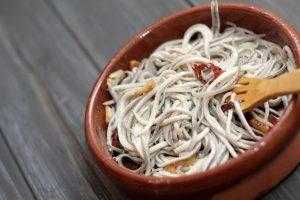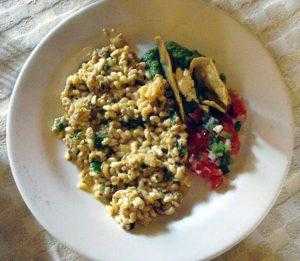Do you love food? If so, then you should check out this list of weird foods from around the world!
This list contains 30 strange foods that you might find interesting. Some of these foods are quite unusual and others are downright bizarre. Some of these foods look very strange but taste amazing.
There’s nothing better than eating delicious foods around the world. So if you want to try something new, here’s a list of weird foods from around the world.
– 30 bizarre foods around the world :
1. Airag (Mongolia)
A traditional Mongolian drink that uses horse’s milk as a base ingredient. It is prepared by fermenting the liquid and then passing it through a fine cloth filter before serving.
2. Alligator (United States)
Alligators are known as reptiles, but they’re actually more closely related to birds than other reptiles. In fact, some scientists believe that alligators evolved from dinosaurs. They’ve been around since the age of the dinosaurs, making them among the oldest living creatures today. Their natural habitat includes swamps, rivers, lakes, and even ponds. Because they prefer the water, alligators are most often seen near bodies of water. However, if there aren’t any nearby, they’ll make do by moving into your backyard!
3. Alpaca (Peru, Chile, and Bolivia)
Alpacas are native to South America. Their meat is mild and flavorful, but less fatty than beef or pork. Alpacas can be cooked in a variety of ways, some of which are similar to beef and pork.
4. Ants Egg Soup (Laos, Thailand)
Ants eggs are a strange delicacy in some parts of Asia. In northern Thailand, there is a dish called “ant eggs” made by boiling up ants’ eggs. They’re compared to having a lot of protein and are considered to be high in minerals.
5. Basashi Raw Horse Meat (Japan)
Raw horse meat is a delicacy in Kumamoto Prefecture, Japan. Like other raw meats, they should be prepared carefully by cutting away any fat before eating. For those who want to try this unusual dish, there are many restaurants in Tokyo serving it. You might also enjoy drinking sake while enjoying this unique meal!
6. Beef Tongue (North America, Mexico)
Beef Tongue is a strange food, but the fact that it is popular in both Mexico and Puerto Rico means that there must be something about it that makes it appealing. There is no other reason why someone would choose to use a beef tongue instead of another kind of meat. In addition, beef tongues are very cheap, making them an even better choice for those who want to make a meal out of them.
7. Blood Sausage (United Kingdom, Ireland)
There are many types of blood sausage around the world. Some countries even make their own versions. In Germany, it’s known as Blutwurst, while in the US, it’s referred to as Black Pudding. People often eat them by themselves, but some also use them as ingredients in other dishes such as meatloaves or burgers.
8. Camel Burger (Somalia, Egypt, Saudi Arabia, Kazakhstan)
You might expect this to taste very much like a normal hamburger, but it actually tastes quite different. Instead of being made up of ground-up cow bones and muscle tissue, it contains mostly fat and connective tissues. So while it may sound strange, it does indeed taste pretty darned delicious!
9. Century Egg (China, Southeast Asia)
You should definitely make sure to include this amazing dish on your China itinerary! These delicious treats were first created during the Song Dynasty and were named after the fact that they could last up to 1,000 years without spoiling. Each part of the egg has a different taste, depending on what ingredients were used to preserve it.
10. Casu Marzu (Italy)
Casu Marzu is a traditional Sardinian dish consisting of a hard cheese filled with live maggots. It is considered to be a delicacy but is illegal in some countries due to health concerns.
11. Baby Eel (Spain)

Baby eels are actually one of the most expensive dishes in Spain. In fact, they’re so pricey that they used to be served as a delicacy, but now they’re more of a luxury item. You can prepare baby eels by simply spicing them up with some garlic and olive oil.
12. Durian (Southeast Asia)
Durians carry a very strong smell, but it’s not quite as bad as some other fruits. That said, it’s still pretty intense. Some say that it smells like rotten eggs or feces, while others describe it more as vomit. Either way, it’s definitely not something you want to bring into public places.
13. Escamoles (Mexico)

Escamoles are delicious ants larvae and pupae, indigenous to central Mexico. They’ve been around since before the Aztec times, so be sure to stop by a local restaurant and try some out while you’re on your Aztec Tour! They’re often served fried, in tacos, in eggs, or with avocado and tortillas.
14. Escargot (France, India, Italy)
Snail meat is often considered a delicacy by many cultures around the world. In fact, snails are sometimes used as a symbol of wealth and status. However, the snail is actually quite poisonous if ingested, and can cause severe stomach pain.
15. Frogs Legs (France)

Frogs aren’t very tasty, but if you want to try something different, then maybe you should give frogs’ legs ago! In fact, you might even enjoy them once you’ve tried them.
16. Ants
Many kinds of ants are edible; such as leafcutters, honeypots and lemons. Some people love eating ants because they think it tastes great, while others may want to cook them before consuming them. To boil ants, pour water into a pan then add the ants. Bring the water to a boil and let simmer for 6 minutes. Remove the pan from heat and allow the liquid to cool slightly. Strain out the ants and serve.
17. Bee Larvae
Bees aren’t great for producing honey alone. People around the world enjoy eating bee larvae as well. Beekeepers tend to feed them to their hives, and some even harvest them alive.
18. Caterpillars
Caterpillars are often considered delicious by some cultures. In South Africa, caterpillars are considered a delicacy. You should avoid hairy or brightly colored caterpillars if you want to catch your own in the wild.
See also
19. Dragonflies
As insects go, dragonflies are easy to catch. You’ll know if you’ve got them because they’ll fly straight into your hand. Once you do get hold of them, you should cook them quickly to avoid having to clean up after yourself. In terms of how long they take to prepare, cooking them takes less than a minute.
20. Fly Pupa
Fly pupa is a nutritious protein source that tastes great. It is very rich in vitamin B12, iron, calcium, zinc, magnesium, and phosphorus. It is also high in omega 3 fatty acids. Many people enjoy eating fly pupae because of their nutritional value.
21. June Bug
Roasting them first makes them more tender, but you can also cook them alive by boiling them or frying them. Both larvae and adults can be used, though larvae are much better when cooked. You’ll get the most out of them if you’re catching them during the day.
22. Hormigas Culonas Big Butt Ants in Colombia
Hormigas Culonas is actually a regional delicacy in Colombia. You may think that the first thing that pops into your head when you hear “big butts” is something else entirely. However, once you get past the initial shock, you’ll discover that hormigas culona is a local specialty in the city of Barichara. We were lucky enough to be there during harvest season, and we had our hands full trying to catch as many as possible.
Ants are insects. They taste like bacon or maybe like dirt.
Hormigas Culonas Ants can be purchased in small bags of a few hand fulls or larger jars at corner stores and shop in the Santander region. We brought a jar home that was a great conversation starter for a while. Eat them as a snack like nuts.
– Where can i buy hormigas culonias?
Hormigas culonas are a popular snack throughout South America, especially in Colombia. You’ll typically see them sold by street vendors, but if you’re looking around town, you might be able to find them in local grocery stores. They are best enjoyed during springtime, but you should be able to get some any time of the year.
Hormigas Culonas are a delicacy in Colombia. You should try them while visiting there.
23. Sannakji Live Octopus in Korea
Sannakji is a Korean dish consisting of boiled octopus tentacles. In this episode, we try it out while shopping for fresh seafood.
Octopuses are often served as sushi or sashimi. In Japan, the octopus is sliced thinly and seasoned lightly. The texture is similar to raw fish but more delicate. The taste is very fresh and briny. You’ll feel like you’re fighting with the tentacles.
Sannakji is a traditional Korean dish made of raw seafood such as squid or cuttlefish. In order to make the most out of the freshness of the ingredients, the whole thing must be consumed immediately after cooking.
24. Morcilla blood sausage in Spain
Blood sausages are made by cooking pig blood with salt, spices, garlic, onions, and other ingredients. The mixture is stuffed into casings or intestines, boiled, and dried. In some cases, the casing may be removed after drying. In any case, the resulting product resembles a regular sausage. However, if you take a closer look, you’ll notice that the sausages are much darker than your usual ones. The reason why they’re called “blood” sausages is that they contain blood as the main ingredient.
Blood sausage is a Spanish dish made with pig blood. It is normally served fried, but sometimes it is used in other ways such as being added to stews or baked into bread rolls. In this experiment, you were given a choice of serving the blood sausage either fried or boiled. You could choose whether to serve them both together on the same plate or separately. You also had the option to add some extra ingredients to your plate. These included a side salad, cheese, olives, pickles, tomatoes, and garlic mayonnaise.
Morcilla is a Spanish traditional meat product made from pork or beef blood mixed with spices and herbs and then cured by smoking. It is used as both a delicacy and a popular snack. In Spain, it is traditionally served cold, often accompanied by bread. It is also commonly consumed as part of tapas dishes.
25. Pupusa in Peru
Pupusas are a type of cornmeal pancake filled with a variety of different foods. This pupusa is filled with shredded chicken breast, black beans, rice, cilantro, onion, and salsa Roja.
The word pupusa comes from the Nahuatl language, which means “little cake”. A pupusa is usually eaten as an appetizer, snack, or dessert. There are many different types of pupusas. Some are filled with ground meat, others with cheese, and still others with vegetables.
26. Kombu Dashi in Japan
Kombu dashi is a Japanese stock made from kelp. It is considered one of the five basic stocks in Japanese cuisine. The kombu seaweed has been used since ancient times in Japan. Today, it is still widely used in making miso soup, tofu, noodles, soups, and sauces.
27. Sushi Rice in Japan
Sushi rice is cooked glutinous rice that is shaped into balls and coated with nori before being placed on top of nigiri sushi. It is typically served with toppings such as salmon, tuna, Ebi, egg, avocado, and cucumber.
28. Chicharrón de Cordero in Mexico
Chicharrones are crispy pieces of pork rinds, which have been deep-fried until golden brown. They are served as snacks throughout Latin America.
29. Tostones in Puerto Rico
Tostones are green plantains that have been fried until crunchy. They can be found all over Puerto Rico, especially during festivals like San Juan’s Festival of St. John.
30. Moringa Leaf Powder in India
Moringa leaves are rich in iron, calcium, phosphorus, potassium, vitamin B6, protein, carbohydrates, fiber, and antioxidants. They are used to make tea, smoothies, juices, salads, and even ice cream!
This list contains the weirdest food around the world. Are there any foods we missed?
Adam Anderson
Related posts
Hot Topics


